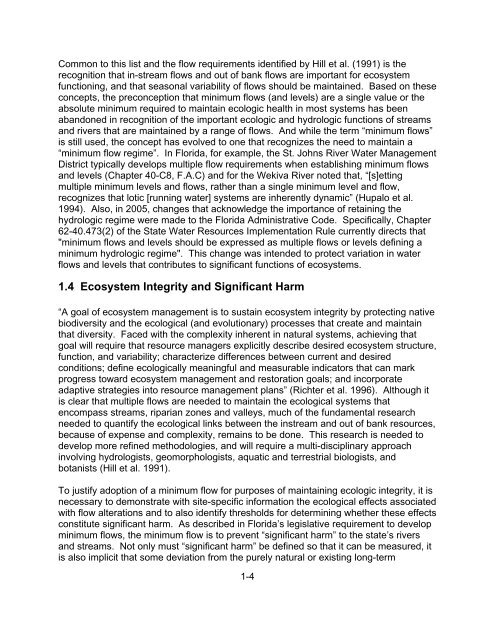Chapter 1 Minimum Flows and Levels - Southwest Florida Water ...
Chapter 1 Minimum Flows and Levels - Southwest Florida Water ...
Chapter 1 Minimum Flows and Levels - Southwest Florida Water ...
Create successful ePaper yourself
Turn your PDF publications into a flip-book with our unique Google optimized e-Paper software.
Common to this list <strong>and</strong> the flow requirements identified by Hill et al. (1991) is the<br />
recognition that in-stream flows <strong>and</strong> out of bank flows are important for ecosystem<br />
functioning, <strong>and</strong> that seasonal variability of flows should be maintained. Based on these<br />
concepts, the preconception that minimum flows (<strong>and</strong> levels) are a single value or the<br />
absolute minimum required to maintain ecologic health in most systems has been<br />
ab<strong>and</strong>oned in recognition of the important ecologic <strong>and</strong> hydrologic functions of streams<br />
<strong>and</strong> rivers that are maintained by a range of flows. And while the term “minimum flows”<br />
is still used, the concept has evolved to one that recognizes the need to maintain a<br />
“minimum flow regime”. In <strong>Florida</strong>, for example, the St. Johns River <strong>Water</strong> Management<br />
District typically develops multiple flow requirements when establishing minimum flows<br />
<strong>and</strong> levels (<strong>Chapter</strong> 40-C8, F.A.C) <strong>and</strong> for the Wekiva River noted that, “[s]etting<br />
multiple minimum levels <strong>and</strong> flows, rather than a single minimum level <strong>and</strong> flow,<br />
recognizes that lotic [running water] systems are inherently dynamic” (Hupalo et al.<br />
1994). Also, in 2005, changes that acknowledge the importance of retaining the<br />
hydrologic regime were made to the <strong>Florida</strong> Administrative Code. Specifically, <strong>Chapter</strong><br />
62-40.473(2) of the State <strong>Water</strong> Resources Implementation Rule currently directs that<br />
"minimum flows <strong>and</strong> levels should be expressed as multiple flows or levels defining a<br />
minimum hydrologic regime". This change was intended to protect variation in water<br />
flows <strong>and</strong> levels that contributes to significant functions of ecosystems.<br />
1.4 Ecosystem Integrity <strong>and</strong> Significant Harm<br />
“A goal of ecosystem management is to sustain ecosystem integrity by protecting native<br />
biodiversity <strong>and</strong> the ecological (<strong>and</strong> evolutionary) processes that create <strong>and</strong> maintain<br />
that diversity. Faced with the complexity inherent in natural systems, achieving that<br />
goal will require that resource managers explicitly describe desired ecosystem structure,<br />
function, <strong>and</strong> variability; characterize differences between current <strong>and</strong> desired<br />
conditions; define ecologically meaningful <strong>and</strong> measurable indicators that can mark<br />
progress toward ecosystem management <strong>and</strong> restoration goals; <strong>and</strong> incorporate<br />
adaptive strategies into resource management plans” (Richter et al. 1996). Although it<br />
is clear that multiple flows are needed to maintain the ecological systems that<br />
encompass streams, riparian zones <strong>and</strong> valleys, much of the fundamental research<br />
needed to quantify the ecological links between the instream <strong>and</strong> out of bank resources,<br />
because of expense <strong>and</strong> complexity, remains to be done. This research is needed to<br />
develop more refined methodologies, <strong>and</strong> will require a multi-disciplinary approach<br />
involving hydrologists, geomorphologists, aquatic <strong>and</strong> terrestrial biologists, <strong>and</strong><br />
botanists (Hill et al. 1991).<br />
To justify adoption of a minimum flow for purposes of maintaining ecologic integrity, it is<br />
necessary to demonstrate with site-specific information the ecological effects associated<br />
with flow alterations <strong>and</strong> to also identify thresholds for determining whether these effects<br />
constitute significant harm. As described in <strong>Florida</strong>’s legislative requirement to develop<br />
minimum flows, the minimum flow is to prevent “significant harm” to the state’s rivers<br />
<strong>and</strong> streams. Not only must “significant harm” be defined so that it can be measured, it<br />
is also implicit that some deviation from the purely natural or existing long-term<br />
1-4
















